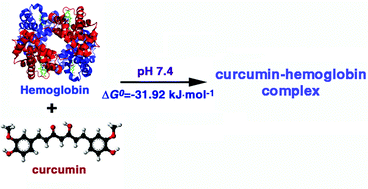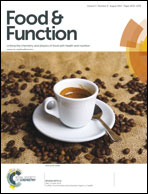Interaction of the dietary pigment curcumin with hemoglobin: energetics of the complexation
Abstract
Thermodynamics of the interaction of the chemotherapeutic and chemopreventive dietary pigment, curcumin, with hemoglobin was studied by isothermal titration calorimetry. The binding was characterized to be exothermic. At 293.15 K, the equilibrium constant for curcumin–Hb complexation was found to be (4.88 ± 0.06) × 105 M−1. The binding stoichiometry was calculated to be 1.08 ± 0.05, confirming a 1 : 1 complexation. The binding was driven by a large negative standard molar enthalpy change (ΔH0 = −118.45 ± 0.05 kJ mol−1) and an unfavorable standard molar entropy change (TΔS0 = −86.53 ± 0.01 kJ mol−1) at 293.15 K. Increasing the temperature favoured the binding, and the magnitude of the negative standard molar heat capacity change suggested the involvement of significant hydrophobic forces in the binding process. With increasing salt concentration, the magnitude of the equilibrium constant decreased slightly; and the complexation mostly involved non-polyelectrolytic forces contributing about 92–94% of the standard molar Gibbs energy change. DSC studies revealed that curcumin binding caused a partial unfolding of the protein.


 Please wait while we load your content...
Please wait while we load your content...